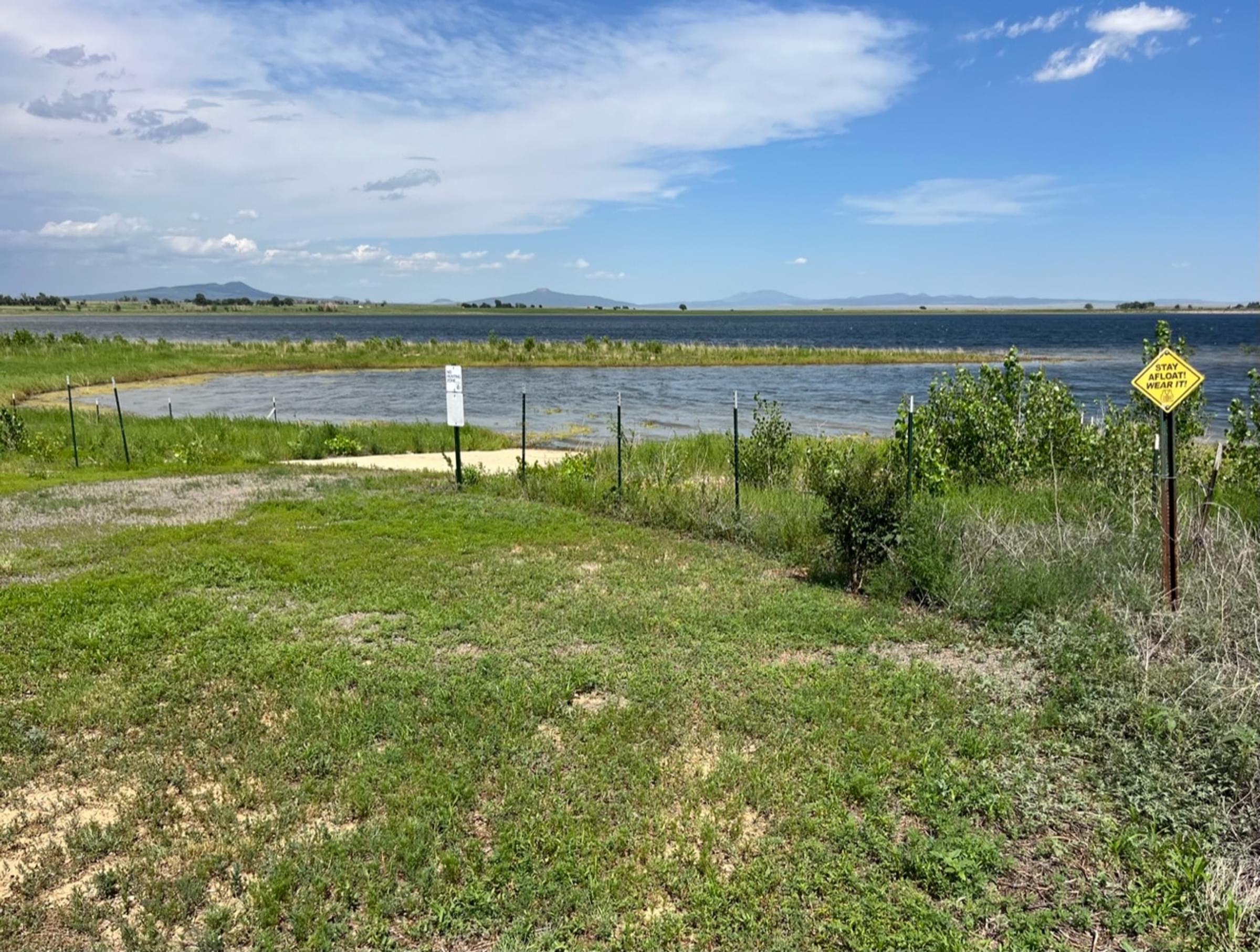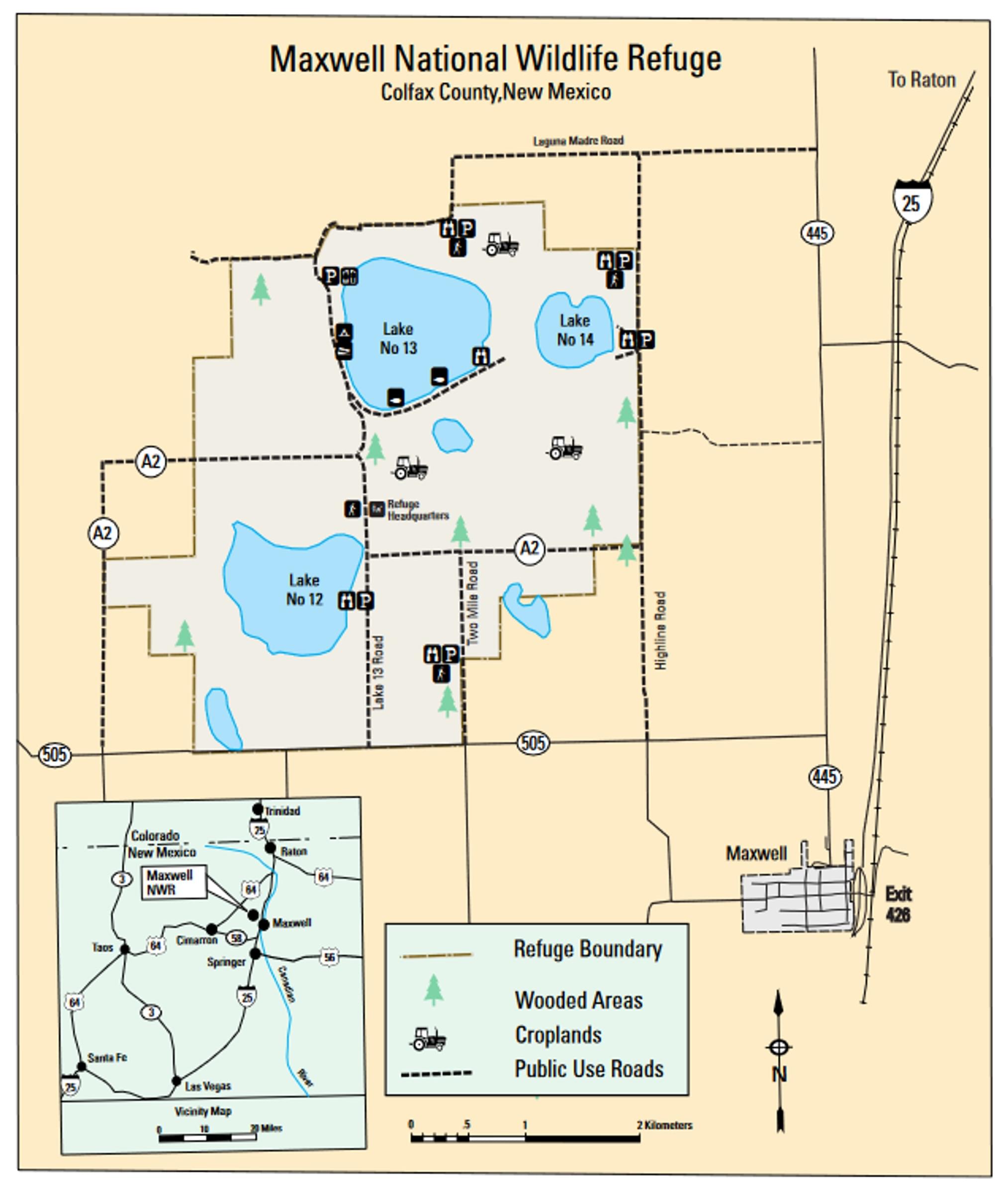Maxwell NWR--Lake 13

Maxwell NWR--Lake 13
Maxwell, New Mexico 87728
Maxwell National Wildlife Refuge Official WebsiteMaxwell National Wildlife Refuge map
Tips for Birding
Although you’re not as likely to see Burrowing Owl here as on County Road A-2 north of Lake 12, or as likely to see Eastern Kingbird as at the Woodlot, this is the Refuge hotspot most frequented by birders. One reason is that other than the Headquarters and Visitor Center, it’s the only hotspot with toilet facilities. Also, it’s a popular camping area despite having no potable water. But what really attracts birders is that Lake 13 is the Refuge playa or reservoir most often at least partially filled, with the drive around the west side of the lake (look for the brown binoculars sign) and across the dam on the south side allowing good waterbird viewing from your vehicle. Far-shore birds can still require a spotting scope for identification. At the east end of the dam, there’s a circular turnout that makes it easy to return as well as park and walk closer to the water. Be advised that we’re not talking about a sandy beach here where the water doesn’t lap the rip-rap of the inner dam face; the shoreline can be extremely muddy. “Entry Prohibited” signage exists both for your safety and the well-being of wildlife.
Birds of Interest
There are interesting birds at Lake 13 regardless of season.
Clark’s Grebe, Broad-tailed Hummingbird, Long-billed Curlew, Pectoral Sandpiper, Lesser Yellowlegs, Northern Harrier, Ferruginous Hawk, Olive-sided Flycatcher, and Chestnut-collared Longspur.
If the lake has substantial water, this is one of the better New Mexico hotspots to practice your gulls. Ring-billed is probably the most common, but California, Franklin's, and Sabine's are often present in different maturities.
About this Location
Lake Number 13 is the largest of the playa lakes located within Maxwell National Wildlife Refuge where water is stored for wildlife habitat and irrigation. It’s generally the deepest, the only one with a boat ramp, and usually the only one where fishing is allowed. Water managed by the Vermejo Conservancy District is diverted from the Vermejo River and Chico Rico Creek, traveling via a series of canals to the lakes. Thus, water flows into Lake 13 from the northwest, through a canal west of the North Viewing Area. Water flows out of the lake to the south, immediately bifurcating to the West 13 Ditch and East 13 Ditch. The marsh or meadow there may be viewed from the dam. Canals and ditches may be dry, or at least have no visible water, when the lake has water. Because the average evaporation rate of the lakes is more than twice that of precipitation, they are typically dry in years where irrigation water is not released to the Refuge by the District. In a very wet year, Lake 13 will cover 325 acres, reportedly with an average depth of 12-13 feet. Whether that’s accurate or not, this is definitely the refuge lake where your probability of seeing an American White Pelican is greatest.
About Maxwell National Wildlife Refuge
See all hotspots at Maxwell National Wildlife Refuge
The Maxwell National Wildlife Refuge presents visitors with a unique wildlife viewing experience. Visitors are treated to year-round views of hawks, owls, eagles, wild turkeys, white-tailed deer, mule deer, and black-tailed prairie dogs.
Located in northeastern New Mexico at an elevation of 6050 feet, Maxwell National Wildlife Refuge encompasses 3,699 acres of short-grass prairie, playa lakes, woodlots, wetlands, and crop fields. The refuge sits in an open basin surrounded by high mesas to the northeast and the Sangre de Cristo Mountains to the west. Since 1965 this landscape has been managed for the benefit of wildlife and has provided a feeding and resting habitat for migratory birds.
Birders and wildlife watchers can challenge themselves by attempting to check off all 289 species of birds found on the refuge. American kestrels, wild turkeys, and Wilson’s phalaropes are a few of the common species you will enjoy seeing at Maxwell National Wildlife Refuge.
Mid-October on the refuge is generally the peak fall migration of sandhill cranes, geese, and ducks. However, any time of year you are likely to see a diversity of wildlife. Wildlife watching is generally best during the morning and at dusk when wildlife is most active.
Rangeland on the refuge is rolling prairie and reclaimed farmland containing a variety of grasses including blue grama, galleta, sand dropseed, threeawn, and buffalo grass, as well as fourwing saltbush and cactus. Lakes on the refuge provide 700 acres of waterfowl roosting and feeding habitat. Wet years bring dense shoreline vegetation, while the lakes may disappear in dry years.
The refuge lakes and associated Stubblefield Lake are primarily for water storage for irrigation purposes for surrounding ranches and are managed by the local water manager. The refuge owns the surrounding grassland but not the water making water management impossible. Stubblefield Lake is privately owned. Fishing is allowed in some areas of the refuge.
From Raton, take I-25 south to Maxwell, go north on NM-445 for 0.8 miles, and west on NM-505 for approximately 2.5 miles. Turn north at the entrance sign (1.5 miles to headquarters).
The vault toilets by the parking area for Lake 13 are seasonally open and maintained. There are flush toilets in the Visitor Center (headquarters building), but that building is open on an extremely limited basis.
Features
Restrooms on site
Roadside viewing
Wheelchair accessible trail
Entrance fee
Content from Maxwell National Wildlife Refuge Official Website and John Montgomery
Last updated October 5, 2023
